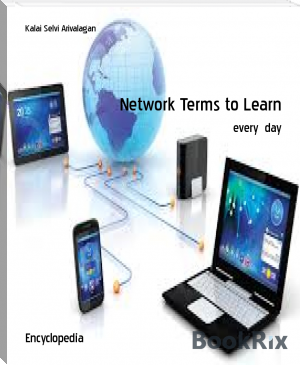Network Terms to Learn - Kalai Selvi Arivalagan (best love novels of all time .TXT) 📗

- Author: Kalai Selvi Arivalagan
Book online «Network Terms to Learn - Kalai Selvi Arivalagan (best love novels of all time .TXT) 📗». Author Kalai Selvi Arivalagan
Feedforward Neural Network
The feedforward neural network is a specific type of early artificial neural network known for its simplicity of design. The feedforward neural network has an input layer, hidden layers and an output layer. Information always travels in one direction – from the input layer to the output layer – and never goes backward.
Parallel Functional Programming
Parallel functional programming refers to a specific philosophy of computer science that uses functional programming in conjunction with parallelism to work with declarative programming in specific ways. By utilizing functional programming this way, developer teams are able to introduce specific operations on interdependent tasks and transformational systems based on parallel algorithms.
Deterministic Automaton
A deterministic automaton is a computer science concept where transition results are determined by the input, and no random arbitration occurs. In a deterministic automaton, there are a set of states, a set of inputs, and a function that brings the result to the next state.
Greedy Algorithm
A greedy algorithm is an algorithmic strategy that makes the best optimal choice at each small stage with the goal of this eventually leading to a globally optimum solution. This means that the algorithm picks the best solution at the moment without regard for consequences. It picks the best immediate output, but does not consider the big picture, hence it is considered greedy.
Insertion Point
In a digital interface, the insertion point is the point at which typed letters, numbers or other inputs are going to be inserted and displayed on the screen. Some of the most common examples of insertion points involve programs like word processors, spreadsheets and text boxes in web forms, where the insertion point is often called the "cursor" and most often appears as a vertical blinking line.
Release Engineer
A release engineer is an individual who is concerned with the mechanics of the development and processing of software products. Release engineering, a sub-spec in software engineering, deals with the accumulation and delivery of source codes into software or programs. These engineers oversee and control the proper placement and deployment of the source code; they ensure that each code is entered in the software code repository and is ready for media duplication and distribution.
Impala
Impala is a type of software tool that is known as a query engine. It is licensed by Apache and runs on the open-source Apache Hadoop big data analytics platform.
Predictive Maintenance
Predictive maintenance is a maintenance strategy driven by predictive analytics. The solutions are used for detecting failure patterns or anomalies, but are only deployed when there is high probability of imminent failure. This helps in deploying limited resources, maximizing device or equipment uptime, enhancing quality and supply chain processes, and thus improving the overall satisfaction for all the stakeholders involved.
Data Sandbox
A data sandbox, in the context of big data, is a scalable and developmental platform used to explore an organization's rich information sets through interaction and collaboration. It allows a company to realize its actual investment value in big data. A data sandbox is primarily explored by data science teams that obtain sandbox platforms from stand-alone, analytic datamarts or logical partitions in enterprise data warehouses. Data sandbox platforms provide the computing required for data scientists to tackle typically complex analytical workloads.
Rich Internet Application (RIA)
A Rich Internet Application (RIA) is a Web application with many of the same features and appearances as a desktop application. A RIA requires a browser, browser plug-in or virtual machine to deliver a user application. Data manipulation is handled by the server, and user interface and related object manipulation are handled by the client machine.
Term of the day - 14 Interrupt Request
An interrupt request (IRQ) is an asynchronous signal sent from a device to a processor indicating that in order to process a request, attention is required. A hardware IRQ is induced by a hardware peripheral or device request, whereas a software IRQ is induced by a software instruction. Both result in processor status savings, and revert to serving the IRQ using an interrupt handler routine.
Integrated Services Digital Network
Integrated Services Digital Network (ISDN) is a set of communication standards for digital telephone connection and the transmission of voice and data over a digital line. These digital lines are commonly telephone lines and exchanges established by the government. Before ISDN, it was not possible for ordinary telephone lines to provide fast transportation over a single line.
Graphics Processing Unit
A Graphics Processing Unit (GPU) is a single-chip processor primarily used to manage and boost the performance of video and graphics. GPU features include:
2-D or 3-D graphics
Digital output to flat panel display monitors
Texture mapping
Application support for high-intensity graphics software such as AutoCAD
Rendering polygons
Support for YUV color space
Hardware overlays
MPEG decoding
These features are designed to lessen the work of the CPU and produce faster video and graphics. A GPU is not only used in a PC on a video card or motherboard; it is also used in mobile phones, display adapters, workstations and game consoles. This term is also known as a visual processing unit (VPU).
Internet Service Provider
An Internet service provider (ISP) is a company that provides customers with Internet access. Data may be transmitted using several technologies, including dial-up, DSL, cable modem, wireless or dedicated high-speed interconnects. Typically, ISPs also provide their customers with the ability to communicate with one another by providing Internet email accounts, usually with numerous email addresses at the customer's discretion. Other services, such as telephone and television services, may be provided as well. The services and service combinations may be unique to each ISP. An Internet service provider is also known as an Internet access provider (IAP).
Network Latency
Network latency is the term used to indicate any kind of delay that happens in data communication over a network. Network connections in which small delays occur are called low-latency networks whereas network connections which suffers from long delays are called high-latency networks. High latency creates bottlenecks in any network communication. It prevents the data from taking full advantage of the network pipe and effectively decreases the communication bandwidth. The impact of latency on network bandwidth can be temporary or persistent based on the source of the delays.
HomePNA
HomePNA (HPNA) is a network technology that uses coax wiring and cabling to operate home telephones and jacks. The HPNA Alliance is an open industry alliance of leading technology companies, service providers and original equipment manufacturers (OEM). HPNA is formerly known as the Home Phoneline Networking Alliance.
Load Balancing
Load balancing is an even division of processing work between two or more computers and/or CPUs, network links, storage devices or other devices, ultimately delivering faster service with higher efficiency. Load balancing is accomplished through software, hardware or both, and it often uses multiple servers that appear to be a single computer system (also known as computer clustering).
Data Lineage
Data lineage is generally defined as a kind of data life cycle that includes the data's origins and where it moves over time. This term can also describe what happens to data as it goes through diverse processes. Data lineage can help with efforts to analyze how information is used and to track key bits of information that serve a particular purpose.
Bayesian Filter
A Bayesian filter is a computer program using Bayesian logic or Bayesian analysis, which are synonymous terms. It is used to evaluate the header and content of email messages and determine whether or not it constitutes spam - unsolicited email or the electronic equivalent of hard copy bulk mail or junk mail). A Bayesian filter is best used along with anti-virus programs.
Non-Uniform Memory Access
Non-uniform memory access (NUMA) is a specific build philosophy that helps configure multiple processing units in a given computing system. In non-uniform memory access, individual processors work together, sharing local memory, in order to improve results.
Booter
In the world of IT security, a booter is a type of service that delivers distributed denial of service (DDoS) attacks for customers. It is a frightening part of the black hat world of cyber warfare that security professionals are concerned about. Booting can be used against nearly any website to deliver pressure that can have many adverse results. Booters are also known as booter services.
Artificial Immune System
An artificial immune system is a system that utilizes some of the engineering of biological immune systems to put together algorithms or technologies that address systemic goals. This may involve mathematical and computer modeling of immune systems, or the abstraction of some immunology-related principles into algorithms.
AWS DeepRacer
AWS DeepRacer is a machine learning project from Amazon that focuses on the development of autonomous racing vehicles on a small scale. Described as a global racing league, AWS DeepRacer allows users to get hands-on experience with machine learning through building cars and working on simulators as well as participating in the world's first autonomous racing league.
ChatOps
The phrase chatOps is used to talk about new platforms and technologies that connect work and the people that work on projects through chat interactivity. It's a somewhat unique and new take on the idea of digital chat technology where messaging apps have allowed us to bridge various communication barriers in unprecedented ways.
Reverse Brute-Force Attack
A reverse brute force attack happens when a hacker or black hat party tries to reverse engineer some security or protection process through utilizing a secondary key or piece of data. It’s the reverse of a conventional brute force attack, which generally seeks to “crack” an account through brute force work on a password or similar key.
Virtual Reality Locomotion
Virtual reality locomotion, or VR locomotion, refers to techniques and technologies that allow users to move within a virtual reality environment. A wide spectrum of VR locomotion methods and processes enables better user experience and more capable interaction with VR systems.
Load Balancing
Load balancing is an even division of processing work between two or more computers and/or CPUs, network links, storage devices or other devices, ultimately delivering faster service with higher efficiency. Load balancing is accomplished through software, hardware or both, and it often uses multiple servers that appear to be a single computer system (also known as computer clustering).
Proof of Stake
Proof of stake (PoS) is a method for cryptocurrency verification through distributed consensus. In a proof of stake system, stakeholders are chosen as creators of a block through analyzing criteria combined with randomization.
Data Communications
Data communications (DC) is the process of using computing and communication technologies to transfer data from one place to another, or between participating parties. DC enables the movement of electronic or digital data between two or more network nodes, regardless of geographical location, technological medium or data contents.
Term of the day - 15




Comments (0)